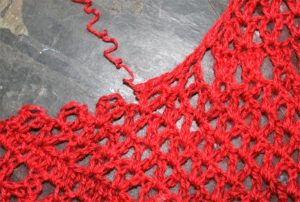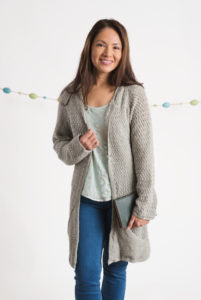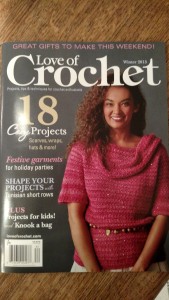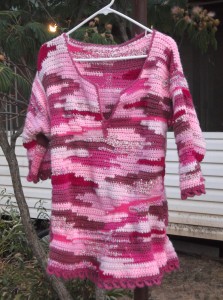 I have mentioned in the past that I had been crocheting for quite a few years before I ever attempted to a sweater. I actually remember the exact “awe ha” moment that spurred me to consider it, I was feeling under the weather, and was grabbing a quick bit at a deli before my work shift began at the local drugstore. A conversation with the sandwich artist behind the counter somehow came around to crochet. He had asked about how to make a sweater, if it was all on piece of pieces put together. My mind automatically shifted to sewing patterns from my days in my 4H sewing project, and it then hit me…I had been crocheting fabric all along. I only needed to crochet the fabric to the shape of the pattern and put it together.
I have mentioned in the past that I had been crocheting for quite a few years before I ever attempted to a sweater. I actually remember the exact “awe ha” moment that spurred me to consider it, I was feeling under the weather, and was grabbing a quick bit at a deli before my work shift began at the local drugstore. A conversation with the sandwich artist behind the counter somehow came around to crochet. He had asked about how to make a sweater, if it was all on piece of pieces put together. My mind automatically shifted to sewing patterns from my days in my 4H sewing project, and it then hit me…I had been crocheting fabric all along. I only needed to crochet the fabric to the shape of the pattern and put it together.
I mention this as I have received some questions lately about the shaping of pieces to create a sweater, and that I often design them with jogged edges. The art of crochet, I have found, is a bit more forgiving than sewing with fabric (granted, I can sew, but it has never been my favorite past time). I have found that crocheting the most basic of shape of the fabric, without worrying about matching the lines exactly, but getting the basic shape, is all that is really necessary to be successful.
 My jogging edges are most frequently found in neckline shaping, and the “bell” shaping at the top of set in sleeves. Yet, in the finished garment these jogs are not noticeable, simply because of seaming and edging. Edgings smooth over these jogs, creating a nice completed finish, while seaming pieces together the jogs can actually allow for a bit more stretch. In the seaming I am usually whip stitching (the act of inserting the needle from only 1 side of the fabric and pushing through to the opposite side, bringing the needle and thread over the seam and reinserting the needle from the same side).
My jogging edges are most frequently found in neckline shaping, and the “bell” shaping at the top of set in sleeves. Yet, in the finished garment these jogs are not noticeable, simply because of seaming and edging. Edgings smooth over these jogs, creating a nice completed finish, while seaming pieces together the jogs can actually allow for a bit more stretch. In the seaming I am usually whip stitching (the act of inserting the needle from only 1 side of the fabric and pushing through to the opposite side, bringing the needle and thread over the seam and reinserting the needle from the same side).
The edges do not match up perfectly on the sleeve seaming, however, you are not usually seaming the top of a stitch to a matching top of stitch. In this process you are often seaming tops of stitches to the sides if rows, and the jogs help you better fit this together.
Basically, don’t worry about over thinking your crochet, minor tweaks and simple tricks can smooth it out and get the result you are hoping for.



